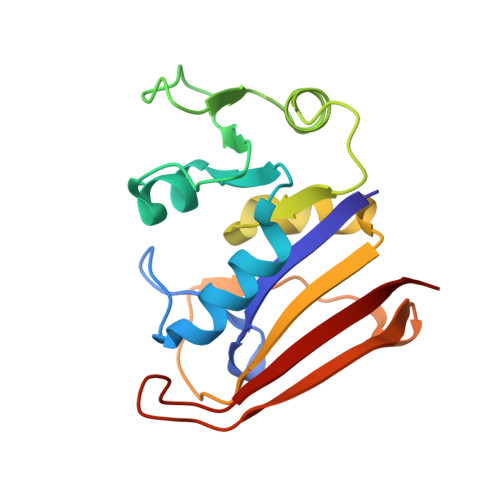X-ray structure of the ternary MTX.NADPH complex of the anthrax dihydrofolate reductase: a pharmacophore for dual-site inhibitor design.
Bennett, B.C., Wan, Q., Ahmad, M.F., Langan, P., Dealwis, C.G.(2009) J Struct Biol 166: 162-171
- PubMed: 19374017
- DOI: https://doi.org/10.1016/j.jsb.2009.01.001
- Primary Citation of Related Structures:
3DAT, 3DAU - PubMed Abstract:
For reasons of bioterrorism and drug resistance, it is imperative to identify and develop new molecular points of intervention against anthrax. Dihydrofolate reductase (DHFR) is a highly conserved enzyme and an established target in a number of species for a variety of chemotherapeutic programs. Recently, the crystal structure of Bacillus anthracis DHFR (baDHFR) in complex with methotrexate (MTX) was determined and, based on the structure, proposals were made for drug design strategies directed against the substrate-binding site. However, little is gleaned about the binding site for NADPH, the cofactor responsible for hydride transfer in the catalytic mechanism. In the present study, X-ray crystallography at 100 K was used to determine the structure of baDHFR in complex with MTX and NADPH. Although the NADPH binding mode is nearly identical to that seen in other DHFR ternary complex structures, the adenine moiety adopts an off-plane tilt of nearly 90 degrees and this orientation is stabilized by hydrogen bonds to functionally conserved Arg residues. A comparison of the binding site, focusing on this region, between baDHFR and the human enzyme is discussed, with an aim at designing species-selective therapeutics. Indeed, the ternary model, refined to 2.3 A resolution, provides an accurate template for testing the feasibility of identifying dual-site inhibitors, compounds that target both the substrate and cofactor-binding site. With the ternary model in hand, using in silico methods, several compounds were identified which could potentially form key bonding contacts in the substrate and cofactor-binding sites. Ultimately, two structurally distinct compounds were verified that inhibit baDHFR at low microM concentrations. The apparent Kd for one of these, (2-(3-(2-(hydroxyimino)-2-(pyridine-4-yl)-6,7-dimethylquinoxalin-2-yl)-1-(pyridine-4-yl)ethanone oxime), was measured by fluorescence spectroscopy to be 5.3 microM.
Organizational Affiliation:
Department of Pharmacology, School of Medicine, Case Western Reserve University, 10900 Euclid Avenue, Cleveland, OH 44106-4965, USA.
















